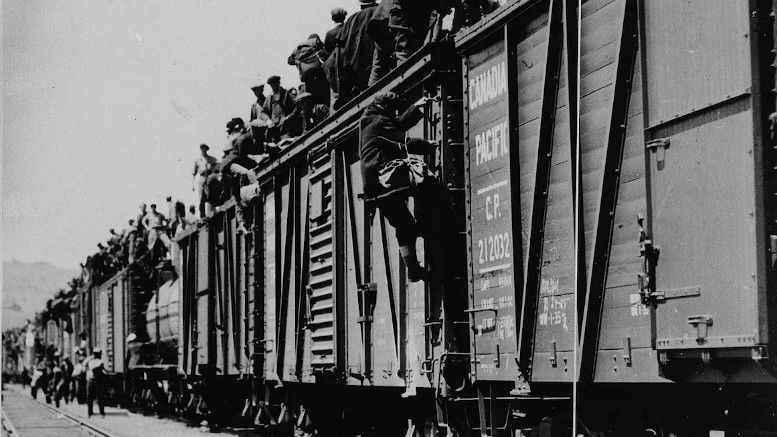Tim Heffernan is retired Ontario Teacher and OSSTF activist.
The leadership of the union representing 60,000 high school teachers and educators in Ontario (OSSTF) is taking its membership into uncharted and dangerous waters as it bargains with the Ontario government. The union has accepted a government proposal to agree to binding arbitration. Contract talks will continue until October 27 and after that any outstanding issues will go to the arbitrator. This means that the union is placing all its eggs in the basket of an arbitrator with no possible recourse to actions like work-to-rule or strike.
Minister of Education Stephen Lecce was grinning like a Cheshire cat when the result of the union vote was announced — he noted that it will have the effect of keeping teachers, education workers and students in classes for the next three years. He also knows that, in the unlikely event of the arbitrator granting a pay increase bigger than the government wanted, he can point to a third party as being to blame.
Prior to the vote taking place, there had been an internal debate within OSSTF as to whether to accept this departure from normal bargaining. On September 27, the result of an online member vote on the issue was announced with, predictably, 78.4 percent in favour. After all, at the end of August, there had been a meeting of Bargaining Unit Presidents and Chief Negotiators who voted overwhelmingly to recommend that members support the process. To their credit, two bargaining units, Toronto and Windsor, broke ranks with the other leadership bodies. This vote effectively means the end of member involvement — there will be no tentative agreement to vote on as the arbitrator’s decision is final. The same arrangement would apply to local negotiations as well, starting a few months later.
Why has the Leadership Done This?
They are presenting the central issue as pay and the need to catch up with inflation and the wages lost under the Ford government’s Bill 124, in effect from 2019 to 2022, which limited annual public sector pay increases to one percent. The government is expecting/hoping that an arbitrator will award them the same kind of pay award that CUPE educators received when they struck last November. The OSSTF leadership is gambling on doing better by getting something similar to what the nurses got in their arbitration award from July 2023, which effectively amounted to wage increases that average 16 percent over two years. However, there is no guarantee that the arbitrator will propose a cost of living (COLA) clause in this contract. Many members were persuaded that the arbitration route would end up giving them a higher pay raise than a strike would.
Historically, the party that thinks arbitration will work for them often pushes for it and then uses the other side’s refusal in its public relations propaganda. Accepting the government’s arbitration proposal plays into the fear of many OSSTF members that a strike that is mainly about salary will not get public support, and that the government would allow a strike to drag on until they judged it the right time to bring things to a close by introducing back-to-work legislation. There was also the perception that if the union went on a negatively perceived strike, that could provide just the excuse that Ford would like to distract from his Greenbelt woes.
Because the arbitrator will be focusing mainly on pay, other issues such as class size, mandatory e-learning, hybrid learning, threats of privatization and government cuts to education most likely will be overlooked. These were precisely the focus for the regional and one-day strikes that the union undertook in 2019-2020. Then, OSSTF had overwhelming parental and public support and won some limited gains. Even a two percent salary increase was perceived as modest. The arbitrator that gets appointed in October will certainly not be deciding on issues such as government cuts, class sizes and e-learning.
Why arbitration is a bad idea
In the period of internal debate on the arbitration proposal, Malcolm Buchanan, former Provincial President and General Secretary of OSSTF, circulated this excellent statement.
Agreeing to interest arbitration is extremely problematic. Consider the following possible consequences:
FACT: By giving up the right to strike normalizes the idea that the right to strike is unnecessary. It demobilizes unions and renders members passive. Because the arbitrator’s decision is binding on the parties, members do not get to vote on the final settlement. Members become mere bystanders.
FACT: Reliance on interest arbitration can actually increase bargaining impasses by reducing the incentive to negotiate the terms that both parties can live with. If an arbitrator is going to decide what the contract says, why budge from one’s initial bargaining position. Imposed contract settlements rarely resolve underlying conflicts and problems. Arbitration is a conservative process. There is no guarantee that wage increases in one sector will be reproduced in others. Arbitration is a poor mechanism for addressing issues like the lack of investment in public education — the real problem facing educational workers.
FACT: While the current context may yield decent arbitration awards, especially on salaries and benefits, the economic situation is constantly changing. What may seem to be a good tactic this time may prove disadvantageous in the long term. Arbitrators usually consider the employers ability to pay, especially for salaries, benefits and contributions to the OTPP (the teachers’ pension plan). The Ford government has made significant financial cuts to public education.
FACT: Arbitration is based on comparisons. That means the quality of arbitration awards is dependent on the success of other unions at the bargaining table to set good salaries, some of whom are forced to use the right to strike to reach settlements that meet their respective members needs. In other words, unions that resort to interest arbitration by choice are essentially free-riding on other unions that have preserved their right to strike to secure improved terms and conditions of employment.
FACT: Forfeiting the right to strike and choosing interest arbitration effectively undermines the bargaining positions of other education unions and helps fuel divide-and-conquer labour relations — exactly what the Ford government wants.
FACT: Voluntarily giving away collective bargaining rights and the right to strike and turning all the power to an arbitrator is dangerous. Anti-union governments don’t have to worry about restricting the right to strike if unions are simply willing to give up that right in exchange for the crutch of interest arbitration.
FACT: OSSTF members in the1970’s had no collective bargaining rights, nor the right to strike. It was only after repeated political pressure and actions, including a massive oneday provincial wide teacher protest that the Conservative Government of Bill Davis started the legislative process to give Ontario teachers collective bargaining rights, and ultimately the right to strike. The result, Bill 100. OSSTF must not surrender collective bargaining rights, and the right to strike, what previous members fought for.
FACT: The OSSTF proposal to continue bargaining until October 27, at which point OSSTF would enter binding arbitration to resolve any remaining issues. This is a weak divisive proposal that will not guarantee a pathway towards securing real investments in public education. OSSTF members should give careful thought as to how they should vote on the No Strike Interest Arbitration Proposal
Unions Divided
There are four teacher/education worker unions in Ontario. OSSTF is the only one to have taken the road of arbitration. Minister Lecce has tried to tempt the other three to go down the same road but without success. For OSSTF, it means “normal” bargaining until October 27 and then arbitration. For the other three unions it is normal bargaining and, if that does not win a good contract, possible strike action. The 83,000 members of ETFO (Elementary school teachers) voted by 95 percent in favour of strikes, and the OECTA (Catholic school teachers – 45,000 members) voted 97 percent in favour of strikes. The smallest union, AEFO (Francophone teachers – 12,000 members) is still negotiating. The overwhelming strike votes of the majority of Ontario’s teachers underlines the mistake of the OSSTF’s leadership. Whatever solidarity that might have existed before among the four unions has now been severely challenged.
Teachers to be made essential workers?
Thereis another danger inherent in this process — that teachers and education workers get classified as “essential workers,” thus permanently giving up the right to strike. In 2016, Ontario’s correctional workers organized by OPSEU (Ontario Public Service Employees Union) agreed to this classification as a means of heading off a strike on pay and other issues. By consenting to give up the right to strike through accepting arbitration, OSSTF has signalled to the government that this right is not viewed as sacred. Previous conservative governments of Bill Davis and Mike Harris tried to curtail the right to strike of teachers. Both times OSSTF pushed back. This time, they didn’t push, they didn’t just acquiesce, they actively promoted it. It’s a huge political win for Lecce and Ford. They got what two prior Conservative governments could not get. In an opinion piece for the right-wing Toronto Sun in September, Lecce showed his real intentions, declaring that students have “a right to learn, from September through to June.” He continued, “Education unions need to get on board with keeping kids in class without disruption, instead of strikes and withdrawal of services. These are not subtle threats. Language like, ‘if we do not get our 52% wage hike demand, then expect strikes’ is what some would call ‘schoolyard bullying.’’’
Courts traditionally have ruled that the most significant criterion for a government declaring workers essential is around public health — if they were to strike would it endanger student health? In this context, it could easily be construed as a warning shot when the Ministry of Education media release, the day after the OSSTF vote, states: “The government continues to make the case that stable in-person learning … will lead to positive mental, developmental, physical health and long-term academic success.” Lecce is looking for stability, an end to “disruptions” as he calls them. It sure looks like, in invoking the dog whistle of students’ health, the conservatives will use this to raise the issue of prohibiting strikes in the education sector — for the benefit of students, of course!
Cuts to Education
If student well-being is such a concern to this government, it’s curious, maybe not, that they don’t see a connection to this and the decline in government funding for education. While the government boasts of its historic investments in education, according to the Canadian Centre for Policy Alternatives, inflation-adjusted school funding is down $1,200 per student since the Ford government came to power. These cuts are more serious in undermining the supports that young people require to grow both physically and mentally and certainly have more of a negative impact than strikes by educators do.
Québec Teachers show the Way
OSSTF, during the period of the Mike Harris years in the 1990s, was once described as the Yorkshire miners of the Ontario teacher unions. This was in the context of their participation in the Days of Action and the two week political protest/strike of the teacher unions. The current leadership is a weak one that did not do anything to organize its members for a whole year. Were they ever going to fight in the first place? Arbitration will not get education workers out of the narrative of austerity and imposition of contracts. The Tories may be around in four years time and if this year’s arbitration tactic goes according to plan, you can be sure they’ll be going for a repeat then. How does this build momentum and strength for the next round?
The terms of the arbitration settlement will be key in determining future consciousness of OSSTF members. Reviving OSSTF’s proud history of militancy is the challenge for its activists. They will not have to work in isolation. Their brothers and sisters in Québec in the union Fédération Autonome de l’Enseignement (comprising nine unions representing 65,500 primary and secondary school teachers), at the end of September, voted for an unlimited strike. Ontario teachers and education workers will need to keep a close eye on the Québec union struggle.
No struggle, no progress
It’s worth considering the wise words of the Black American, anti-slavery activist, Frederick Douglass:
“If there is no struggle, there is no progress. Those who profess to favor freedom, and yet depreciate agitation, are men who want crops without plowing up the ground. They want rain without thunder and lightning. They want the ocean without the awful roar of its many waters. This struggle may be a moral one; or it may be a physical one; or it may be both moral and physical; but it must be a struggle. Power concedes nothing without a demand. It never did and it never will.”



